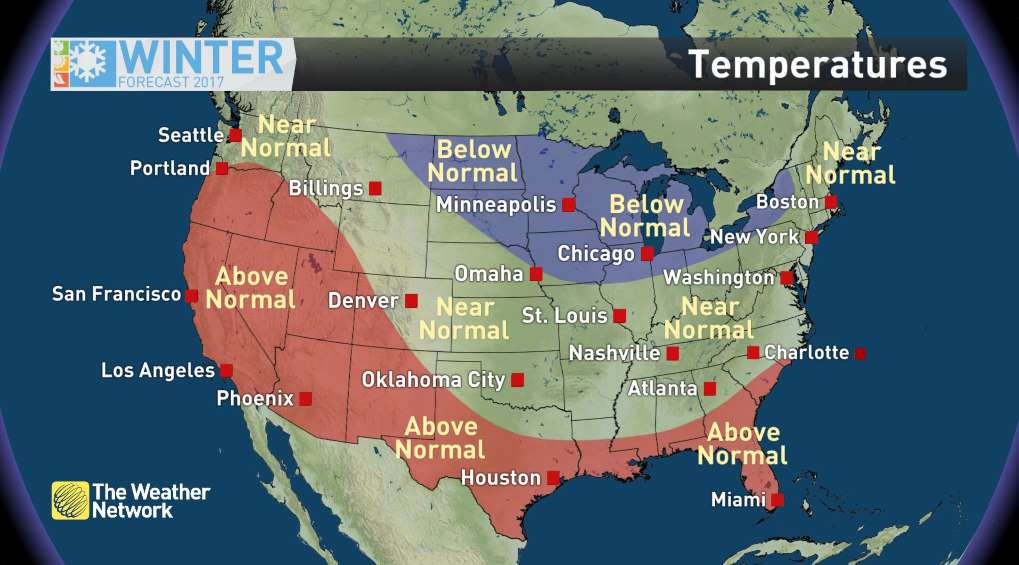November 22, 2016
The Weather Network is forecasting a return to more typical winter weather this year across much of the country, in sharp contrast with the exceptionally mild season of 2015-2016.

Winter Forecast: Classic American winter welcomed home
November 22, 2016
The Weather Network is forecasting a return to more typical winter weather this year across much of the country, in sharp contrast with the exceptionally mild season of 2015-2016.

Winter Forecast: Classic American winter welcomed home
Though some will experience above normal temperatures this season, many parts of the country that saw a lack of sustained winter weather last year will have to endure more frequent storms and bouts of arctic air in 2016-2017. Exactly where will the flakes be flying, and who can look forward to a dry and mild season? Read on for all the details on the next three months, in our 2016-2017 Winter Outlook.
Below normal temperatures will dominate this winter across the north-central US, including the Great Lakes and upper Midwest. Now that last year's El Nino has given way to a weak La Nina event, we expect the door to be open for frequent shots of arctic air into the middle of the country, some of which may bring extended periods of bitter cold.
If there is a silver lining to the forecast, it's that we should see a more progressive pattern this season. That means there will be periodic breaks in the cold, leading to an occasional thaw. However, on the whole we expect below normal temperatures for the season for cities like Minneapolis, Chicago, and Detroit.
Frigid temperatures may be more persistent across the north, but a large swath of the country east of the Rockies will be susceptible to waves of arctic air this season. This will bring the return of more typical winter weather from the east coast down through the Ohio Valley and into the heartland.
Across the middle of the country, arctic air from the north will battle it out with milder southerly flow. This will contribute to an active winter storm season – more on that in a moment – but also lead to frequent back-and-forth temperature swings this season.
Cities across the country that were mild last winter will see more persistent periods of cold this year, leading to overall temperatures near normal for the season. This includes the major northeastern metros of Boston, New York, and Washington D.C., as well as cities across the lower Midwest and South such as St. Louis, Oklahoma City, Nashville, and Atlanta.
If you're looking for milder temperatures east of the Rockies this season, head to the southeastern coast, where warmer than normal conditions should dominate for parts of the Carolinas, Georgia, and the Gulf Coast.
Aided by warm water temperatures and a favorable jet stream pattern, the southern coastal regions of the US, including Charleston, New Orleans, and Houston should resist the influence of arctic air for the most part this season. A dry and mild pattern is great news for snowbirds, though on occasion strong fronts will lead to periods of below-normal cold even for the deep south.
The most persistent warmth to be found this winter will be out west, where a resilient ridge of high pressure will sustain the influence of mild Pacific air. This will bring above normal temperatures to places like Los Angeles, San Francisco, Salt Lake City, and Phoenix.
Temperatures are one part of the seasonal story, but precipitation – and especially snowfall – plays a key role in how severe a winter feels. Here's a look at the precipitation pattern, which highlights an active winter storm season for much of the northern US, but unfortunately spells bad news for some of the country's most drought-stricken regions in the south.
An energetic and variable storm track is expected across the northern tier of the US this winter. This will be driven by an amplified jet stream pattern, with frequent intrusions of arctic air from the north battling against milder conditions entrenched in the south. An abundance of storm systems should produce near normal precipitation across a broad swath of the country, including much of the Plains, lower Midwest, and Mid-Atlantic coast.
Coupled with the expected swings in temperatures, a wide variety of storm tracks also means a wide range of precipitation types will accompany this year's storms. For any given city along a storm's path, that could mean rain, snow, ice, or all of the above. Also keep in mind that it only takes one significant storm to make a winter memorable, and even areas in the "Near Normal" precipitation region may see a significant wallop or two this season.
East of the Rockies, the territory most likely to see above normal precipitation this winter is the Great Lakes and northern New England. We expect numerous storm systems here, and with cold air in place, that means abundant snowfall. This will be particularly true in the lake effect snowbelts, where warmer than normal waters should keep the lakes active deep into the season.
In the west, the storm season got off to an early start this year, with frequent systems and a nearly constant stream of Pacific moisture impacting the Northwest through the fall. This active pattern will continue through the winter, bringing overall precipitation totals to above normal in what is already the climatologically rainy/snowy season for this region.
Near normal snowfall is expected for much of the Mountain West this year, particularly the northern ranges. This should be good news for skiers, despite the warmer than normal pattern.
Unfortunately this pattern offers little good news for Southern California, which will likely see a continuation of extreme drought conditions into 2017. In fact a dry winter is likely across the entire southern tier of the country, including the Southeast, which has seen its own drought problems deepen in recent weeks. The driest territory in Mississippi, Alabama, Georgia, and eastern Tennessee are likely to see their rainfall totals lag even further behind average in the months ahead.
Courtesy: Weather Network







































































































